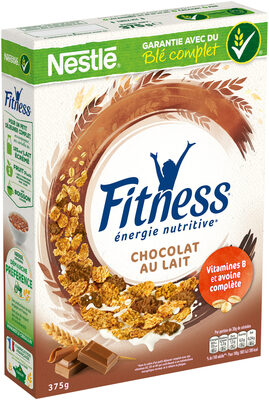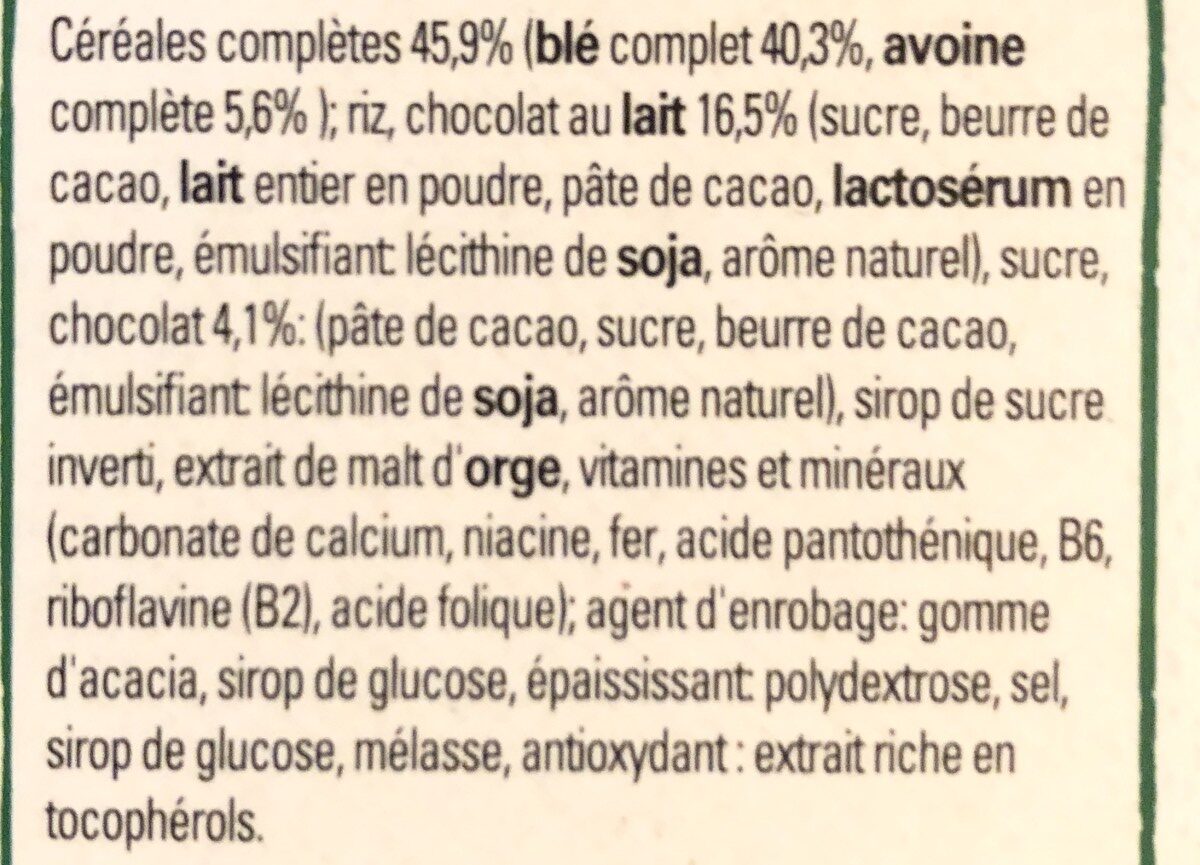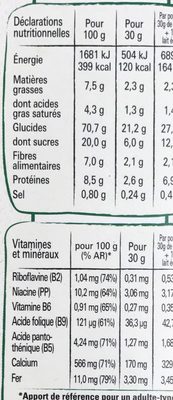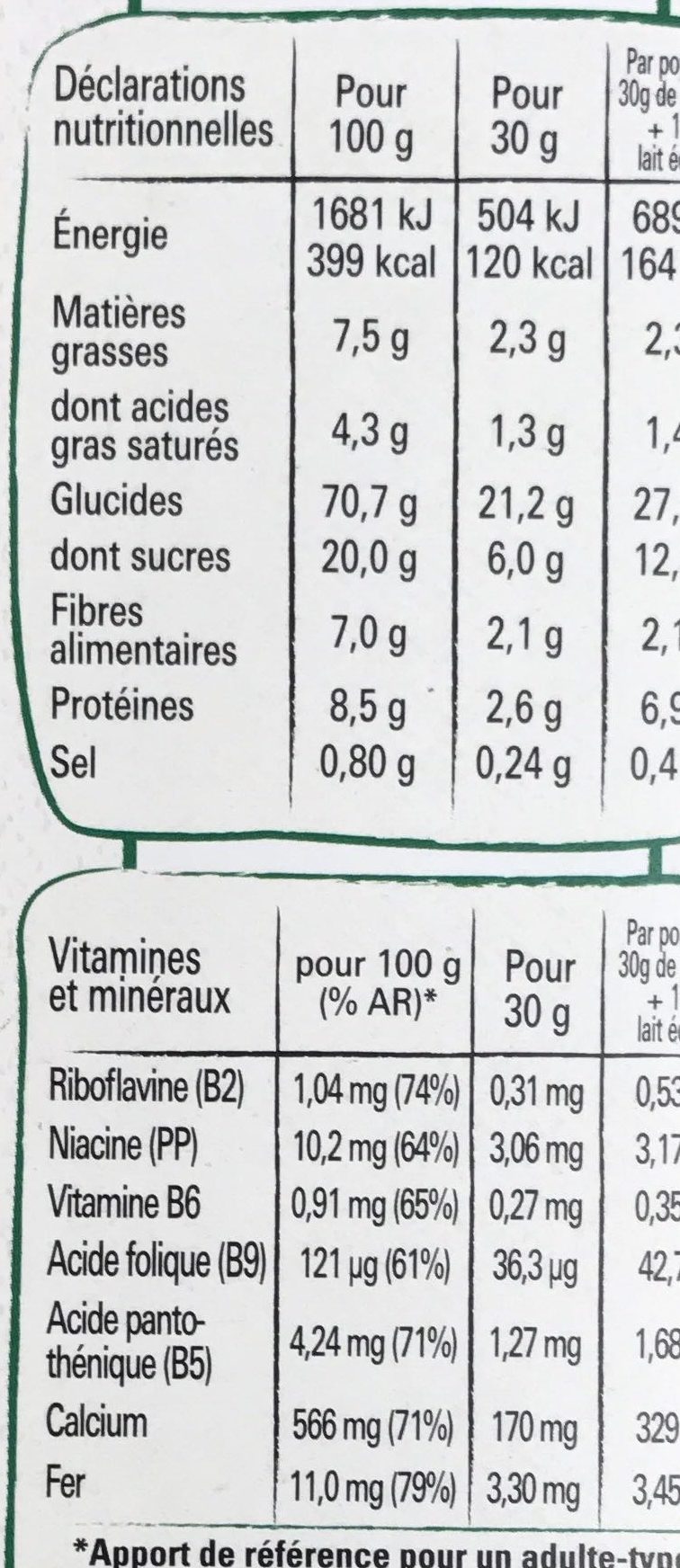Chocolat au Lait - Nestlé - 375 g
This product page is not complete. You can help to complete it by editing it and adding more data from the photos we have, or by taking more photos using the app for Android or iPhone/iPad. Thank you!
×
Some of the data for this product has been provided directly by the manufacturer NESTLE FRANCE. - Customer service: Contact form 0 809 400 412 (service gratuit + prix de l'appel)
Barra-kodea: 3387390326468 (EAN / EAN-13)
Izen arrunta: Pétales de blé complet, de riz et d'avoine complète avec des pétales (36,25%) enrobés de chocolat au lait, enrichis en vitamines (B3, B5, B6, B2, B9), calcium, fer
Kopurua: 375 g
Ontziratzea:
en:Box, en:pack, en:Green dot, fr:Boîte carton à recycler, fr:Etui en carton, fr:Film en plastique, fr:Pensez au tri!, fr:Sachet plastique à jeter
Kategoriak: en:Plant-based foods and beverages, en:Plant-based foods, en:Breakfasts, en:Cereals and potatoes, en:Cereals and their products, en:Breakfast cereals, en:Chocolate cereals, en:Extruded cereals, en:Cereal flakes with chocolate
Etiketak, ziurtagiriak, sariak:
en:No artificial flavors, en:Green Dot, en:Made in France, en:No artificial colors, en:No artificial colours or flavours, Nutriscore, Nutriscore C, Triman, pt:Fonte de fibra

Origin of the product and/or its ingredients: FRANCE
Manufacturing or processing places: Itancourt, Picardie, France
Saltzen diren herrialdeak: Belgika, Frantzia, Alemania, Italia, Luxenburgo, Maroko, Portugal, La Réunion, Espainia, Suitza, Tunisia
Matching with your preferences
Ingurumena
Carbon footprint
Ontziratzea
Transportation
Other information
Conservation conditions: Bien refermer le sachet intérieur après chaque utilisation et conserver dans un endroit frais et sec.
Customer service: Cereal Partners France, 34-40 rue de Guynemer 92130 Issy-les-Moulineaux
Report a problem
Datuen iturria
The manufacturer NESTLE FRANCE uses Equadis to automatically transmit data and photos for its products.
Product added on by openfoodfacts-contributors
Last edit of product page on by october-food-facts.
Produktuaren orria -gatik editatua aleene, ankedanay, beniben, choosebetter, countrybot, date-limite-app, ecoscore-impact-estimator, foodless, foodrepo, hangy, inf, jbarcelona, julie-yuka, kiliweb, magasins-u, manu1400, moon-rabbit, musarana, nicormd, nouky20, org-app-elcoco, org-nestle-france, packbot, roboto-app, scanbot, tacite, tacite-mass-editor, thaialagata, yuka.RnFBOUg3MWZ0K1E0b2NVOTlESDgyK2xGOTdhRVZ6N3NDZkFlSWc9PQ, yuka.UVA0WkVJc0FxdU1vb01ZMDJqR0srOUZ6N0srcFdtNk1DT0ZBSUE9PQ, yuka.WUxJT01vazcrY0pUb3RnYzNpTHZwSXhGeGEyU1JrK01kOHM0SVE9PQ, yuka.YWFRTk9wc1l2TndOb2NWbjBUVDYrODVTMWFDNWNsdnJML0ZKSUE9PQ, yuka.YklFL09xODZ0dmM2eTlnOTRCNzE1K2hmNGFlSEIzcUxkZmhBSVE9PQ, yuka.YmZnK0w2VUxpS0U2cC9CaTVCU0Z4b3RVbDdtQWYwYW1FZVU0SUE9PQ, yuka.ZC9nckhMVWNwK01hbC9FL29oL0p4ZkJXOXJPdUEzR0xlc2NlSWc9PQ, yuka.ZVlJT05yaFpnTUVsZ1BRdi9TN015L0Fzd3NTT1FWaXVFTW9vSVE9PQ, yuka.ZW9sZURaMVloZlE3b05zanBUUC9wc3BJbDVxc1ptR1BkY0VPSWc9PQ, yukafix.










